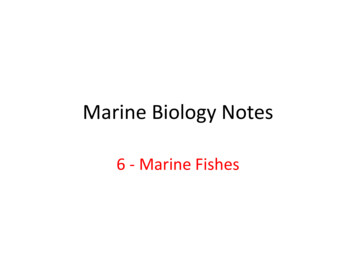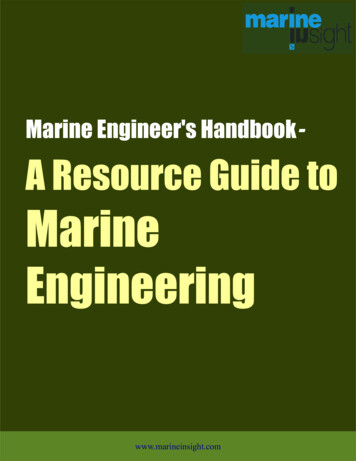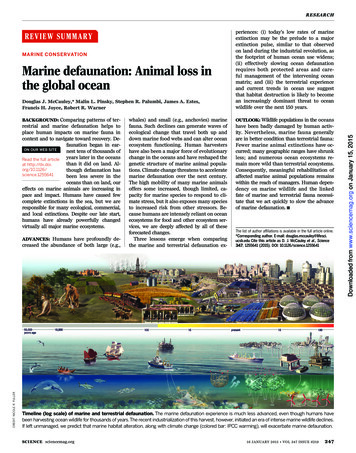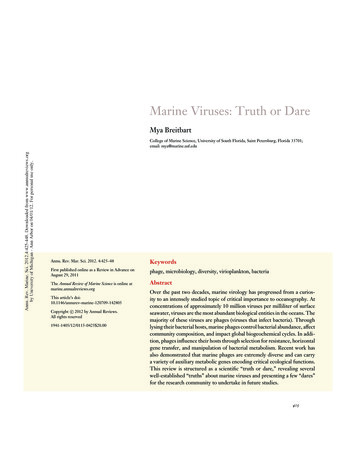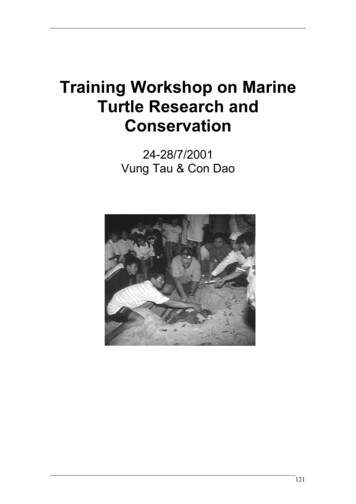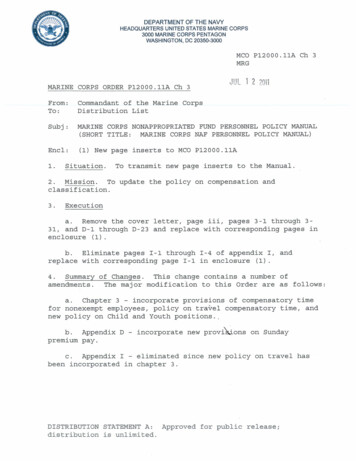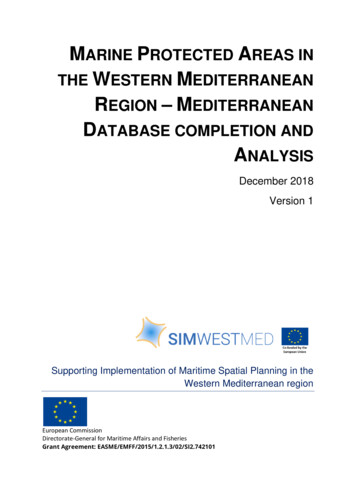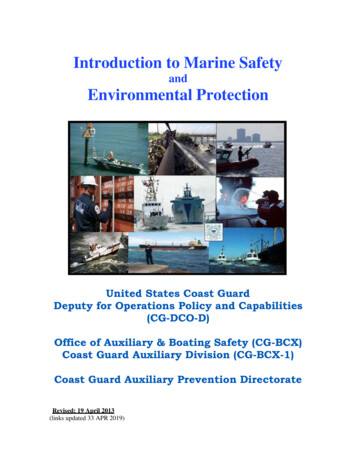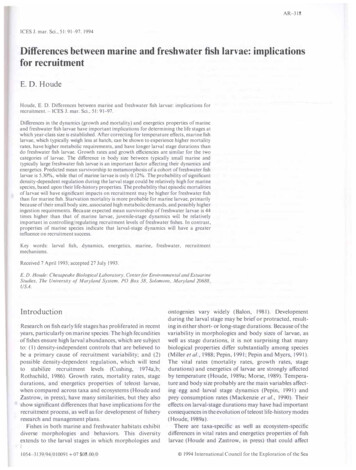
Transcription
AR-318ICESJ.mar.Sci.,51:91 97. 1994Differences between marine and freshwater fish larvae: implicationsfor recruitmentE. D. HoudeHoude, E. D. Differences between marine and freshwater fish larvae: implications forrecruitment. ICES J. mar.Sci., 51: 91-97.Differences in the dynamics (growth and mortality) and energetics properties of marineand freshwater fish larvae have important implications for determining the life stages atwhich year-class size is established. After correcting for temperature effects,marine fishlarvae, which typically weigh less at hatch, can be shown to experience higher mortalityrates, have higher metabolic requirements, and have longer larval stage durations thando freshwater fish larvae. Growth rates and growth efficiencies are similar for the twocategories of larvae. The difference in body size between typically small marine andtypically large freshwater fish larvae is an important factor affecting their dynamics andenergetics. Predicted mean survivorship to metamorphosis of a cohort of freshwater fishlarvae is 5.30%, while that of marine larvae is only 0.12%. The probability of significantdensity-dependent regulation during the larval stage could be relatively high for marinespecies, based upon their life-history properties. The probability that episodic mortalitiesof larvae will have significant impacts on recruitment may be higher for freshwater fishthan for marine fish.Starvation mortality is more probable for marine larvae, primarilybecause of their small body size, associated high metabolic demands, and possibly higheringestion requirements. Because expected mean survivorship of freshwater larvae is 44times higher than that of marine larvae, juvenile-stage dynamics will be relativelyimportant in controlling regulating recruitment levels of freshwater fishes. In contrast,properties of marine species indicate that larval-stage dynamics will have a greaterin0uence on recruitment success.Key words: larval fish, dynamics, energetics, marine, freshwater, recruitmentmechanisms.Received 7 April 1993; accepted 27July 1993.E. D. Houde: Chesapeake Biological laboratory, Center for Environmental and EstuarineStudies, The Unil'ersity of Maryland System. PO Box 38, Solomons, Maryland 20688,USA.IntroductionResearch on fish early life stages has proliferated in recentyears, particularly on marine species. The high fecunditiesof fishes ensure high larval abundances, which arc subjectto: (I) density-independent controls that are believed tobe a primary cause of recruitment variability; and (2)possible density-dependent regulation, which will tendto stabilize recruitment levels (Cushing, 1974a,b;Rothschild, I986). Growth rates, mortality rates, stagedurations, and energetics properties of teleost larvae,when compared across taxa and ecosystems (Houde andZastrow, in press), have many similarities, but they alsoshow significant differences that have implications for therecruitment process, as well as for development of fisheryresearch and management plans.Fishes in both marine and freshwater habitats exhibitdiverse morphologies and behaviors. This diversityextends to the larval stages in which morphologies and1054 3139I 94I 010091 07S08.00 0ontogenies vary widely (Balon, 1981). Developmentduring the larval stage may be brief or protracted, result ing in either short- or long-stage durations. Because of thevariability in morphologies and body sizes of larvae, aswell as stage durations, it is not surprising that manybiological properties differ substantially among species(Miller et al., 1988; Pepin, I991; Pepin and Myers, 1991).The vital rates (mortality rates, growth rates, stagedurations) and energetics of larvae are strongly affectedby temperature (Houde, 1989a; Morse, 1989). Tempera ture and body size probably are the main variables affect ing egg and larval stage dynamics (Pepin, 1991) andprey consumption rates (Mackenzie et al., 1990). Theireffects on larval-stage durations may have had importantconsequences in the evolution of teleost life-history modes(Houde, I989a).There are taxa-specific as well as ecosystem-specificdifferences in vital rates and energetics properties of fishlarvae (Houde and Zastrow, in press) that could affect 1994 International Council for the E xploration of theSea
92 . D. Houderecruitment levels, in addition to influencing dynamicsand energetics of older life stages. Houde and Zastrow (inpress) noted some probable differences in larval-stageproperties of marine and freshwater fish larvae in abroader analysis across aquatic ecosystems and taxa.In the present paper. I critically compare averagedproperties of larvae from the combined marine eco systems with properties of larvae from freshwaterecosystems and discuss the potential for regulation andcontrol of recruitment during the larval and juvenilestages in each system.MethodsData on larval dynamics (vital rates) and energetics,categorized by ecosystems and by taxonomic groups.were compiled by Houde and Zastrow (1991, in press).Those reports included data on both freshwater andmarine tclcost larvae. but the analysis and interpretationsdid not focus on implications for recruitment in fresh water and marine ecosystems. Herc, the analysis isextended explicitly to examine and compare the relation ships between size at hatching and vital rate parametersin the two categories of larvae. Recruitment levels ineach case arc predicted for mean values of rates estimatedduring larval life. and simple simulations arc run todemonstrate the extent to which average dynamics in thelarval stage must vary to precipitate important changes inrecruitment levels.Most tcleost taxa for which published data were avail able arc included in the analysis. Exceptions were a fewtaxa of principally freshwater fishes with unusually large.precocial (se11.1u Balon, 1981) hatchlings that have eithera curtailed or absent larval stage. e.g. Salmonidac,Acipenseridac, lctaluridae. The variables that were con sidered are: W0 dry weight at hatching (µg): W m ei dryweight at metamorphosis (µg): G weight-specificgrowth coefficient (µg µg ' day- 1 ): Z instantaneousmortality coefficient (day- 1 ): D larval- stage duration(day): 1.c. days to grow from WO to W m e,; QO 2 weight specific oxygen uptake (µI 0 2 mg- 1 h- 1 ); I weight specific food mgcstion (day 1 ), i.e. fraction of larval bodyweight consumed daily; and K 1 gross growth efficiency,defined as GI I.Temperature-adjusted mean values of each parameterfor larvae from five marine ecosystems and freshwater.and from nine broad taxonomic groups. were estimated(Houde and Zastrow. 1991, in press). Adjustments for thesubstantial temperature effects were accomplished viaanalysis of covariance. Mean values that arc reported herefor data from pooled marine ecosystems and from frcsh w tcr systems are those compiled by Houde and Zastrow(in press). except for minor differences resulting from afew additions or changes to the earlier data set. Thesevalues arc referred to as "typical" or "average" for larvaefrom marine or freshwater systems, acknowledging thatsuch characterization docs not recognize species whicharc atypical and whose life histories may deviate signifi cantly from the norm. Differences between means werejudged to be significant at a 0.10, rather than at 0.05.to increase the power of the tests to detect probabledifferences in these quite variable data. which often werebased upon few observations.Regression statistics relating G, z. D. and QO 2 to W0were calculated to dctermmc if these variables were de pendent upon weight at hatching. and if the dependencediffered between freshwater and marine larvae. Expectednumbers of metamorphosed survivors. at mean values ofvital rates and ontogcnic attributes. were calculated forfishes from freshwater and marine ecosystems, basedupon the relationship:-Z(log. w m -log. W0)]N 0e [---N m .,-PxG())where N m., number of metamorphosed survivors:N 0 initial number of larvae; and P probability ofsurviving "episodic" mortality events.The ratio of N m rw N m ·MAR for equal N 0 was calcu lated to indicate relative stage-specific survivorship. Byvarying Z. G, and Pin Equation (I). the changes in ratesor episodic loss probabilities were calculated that arerequired to cquali,c survivorship at metamorphosis in themarine and freshwater ecosystems. Effects of initial eggor larval numbers (i.e. variability in N 0), caused b)differences in mean fecundities between marine and fresh water fishes, and the consequences for survivorship atmetamorphosis, were considered. Telcost fecundity datacompiled by Winemiller and Rose (1992) were used forthis purpose.The potential for density-dependent regulation oflarval survival via growth-rate responses to initial larvalabundances was compared for marine and freshwater fishlarvae by simulating responses of N m ., in Equation ( I) tovariability in Ci and N 0 In an example, Ci was reduced by10, 25, or 50% per five-fold increase in N0 Then, theexpected survivorships were compared for marine andfreshwater larvae to determine their sensitivities todensity-dependent growth.ResultsMarine fish larvae. on average. are smaller at hatch.suffer higher mortality rates, have higher weight-specificrespiration rates, and have longer stage durations than dofreshwater larvae (Table I). The I0-fold difference inmean weight at hatching potentially has important conse quences for larval-stage dynamics and recruitment.Weight-specific growth rates do not differ significantly.nor do gross growth efficiencies, although the data base for the latter is small. The calculated mean.
Differences het,reen marine and/reslt11·ater/i.1lt larvae93Table I. Temperature-adjusted (by analysis of covariance) means of dynamic and energeticsproperties of marine and freshwater fish lar,ac. Symbols for variahles arc defined 111 text (secMethods). Significance 111dicates p :!,'.'Q.10. n number of taxa. s.r. -standard error of FnXs.r.n37.610 845.60.2000.23936.15.900.290.576.4953.00.01 I0.021I 020 72.790.320.4672.81604.30.0190.040I .s1g.s1g.s1g.n.s.11.S.Table 2. Expected energy budgets (cal mg I day 1) of marine and fresh,,atcr fhh larvae.(a) Temperature-adjusted mean energy budgets (from Houde and Zastr l\\. 111 press). (h)Temperature-adjusted energy budgets. standardized to one unit of grm,th. (Note that nostandardization \\as required for marine larvae whose mean budget h1 co111c1dence was 1.0 forthe growth component.) (c) Temperature-adjusted energ 1 hudgets. standardized to one unit ofingestionCategory(a) ManneFreshwater(b) ManneFreshwater(c) MarineFreshwaterIngestiongrowth metabolism3.442.78LOO0.891.001.000.290.32 cific ingestion rates. which were derived fromthe growth rate and growth efficiency data. are 0.57 formarine larvae and 0.46 for freshwater larvae. Thesevalues were not found to differ significantly at the a 0.10level.Weight-specific growth rates (G) for the pooled dataof marine and freshwater larvae. and of the freshwaterlarvae alone. arc significantly correlated with W0 (Fig.Ia). but no relationship between G and WO is apparent forthe marine larvae over the relatively small range of W 0that is represented. No significant relationship betweeninstantaneous mortality rate (Z) and W 0 was demon strated (Fig. l b). although the highest rates arc reportedfor some of the smallest marine larvae. There is also nosignificant correlation between larval-stage duration (D)and W0 (Fig. le), but the longest-stage durations wereestimated for some of the smallest mannc larvae. Thequite strong relationship between weight-specific oxygenuptake (QO 2) and W0 which was reported previously forcombined annc and freshwater larvae by Houde andZastrow (in press) 1s illustrated (Fig. Id). In the presentanalysis. the QO 2 vs. W O relationship was significant forthe freshwater larvae. but not for the marine larvae. unne feces 0.240.190.240.220.070.07 1.211.231.211.390.150.44 Applying mean \'alucs (Table I) m Equation (I) indi cates that relative survivorship at metamorphosis of a"typical" cohort of freshwater fish is expected to be 44times higher than that of a "typical" cohort of marinefish. At metamorphosis. 5.30 -o of an initial freshwatercohort is expected to be alive compared to only 0.12% of amarine cohort. Thus. a much larger fraction of a typicalfreshwater, larval cohort will survive to enter the juvenilestage.Quite large changes in either Z or G are necessary toequalize expected survivorships at metamorphosis ofmarine and fresh\\ater fish larvae. A 2.3-fold increase in Zor decrease in G by a typical cohort of freshwater larvae isnecessary to reduce its sur\ival at metamorphosis to0.12 10, the estimated survivorship of a typical cohortof marine larvae. Exactly the opposite applies to marinelarvae; a typical cohort of marine larvae would need toexperience 2.3-fold lower Z or higher G to supportsurvivorship of 5.30 10 at metamorphosis. the expectedlevel for a typical freshwater cohort.If episodic mortalities of larvae i.e. weather-relatedevents. arc more prevalent in freshwater than in marineenvironments, such losses would tend to equalize
94E. D. Houde:;IQ02(µI 0 2 mg - 1,.c::10050012LJ.I -.:. -- I 6-E150(b).(d l."·8 J.D dayl0200.0.2 "0.4(a) '40.8 0.6 0.40.200.6 -,. Z (day -1)G dayJ-61 c,I 14 t 40"' 200 reductions inGare required to generate a similar responsein freshwater larvae. The result indicates that survivalof marine fish at metamorphosis not only is relativelymore sensitive to external controlling factors that affectmortality rates and stage durations, but that marinespecies also have more potential to regulate theirabundance in the larval stage.The expected energy budgets for marine and freshwaterfish larvae, calculated from the temperature-adjustedmean growth rates, ingestion rates, and weight-specificoxygen uptakes, arc similar in most respects (Table 2a).After standardizing budgets to one unit of growth (Table2b), the budgets differ principally in the metabolismcomponent, which is nearly two times higher for thesmaller marine larvae. Budgets standardized to one unitof ingestion (Table 2c) show that metabolism is 29% ofingested energy for marine larvae but is only 17% forfreshwater larvae. Average assimilation efficiencies[(Ingestion - Feces)-:- Ingestion] apparently are higherfor marine (65%) than for freshwater fish larvae(56%), primarily because marine larvae have a highermetabolic level, not because they grow faster or moreefficiently. 600400800 1000Weight at hatch (µ.g dry)12001400Figure I. The relationships between dry weight at hatching and(a) weight-specific growth rate, (b) instantaneous mortality rate.(c) larval stage duration, and (d) weight-specific oxygen uptakefor marine and freshwater fish larvae.expected survivorships at metamorphosis in the two sys tems. But, at the mean Zand G levels of freshwater fishlarvae (Table I), additional episodic losses [P in Equation(I)] would have to reduce initial cohort abundance by97.8% to match the expected survivorship of a typicalcohort of marine larvae. If episodic mortalities, e.g.caused by aberrant transport or storm events, are animportant element contributing to mortality of marinefish larvae, any such losses would tend to reduce furthertheir expected survivorship at metamorphosis, and thuswiden the gap even more between expected survivorshipsof freshwater and marine larval cohorts.Decreases in growth rate, if density-dependent, poten tially could have relatively strong effects of survivorshipat metamorphosis of marine fish larvae compared tofreshwater larvae (Fig. 2). The potential for regulationof abundance of marine larvae via density-dependentgrowth is relatively high because their stage durations arelong, their ratio ofG:Zis low, and their ratio ofW me1:W0is high. Reductions in weight-specific growth rate of 25% per five-fold increase in initial larval abundancewill induce a strong density-dependent response in rela tive survival of marine larvae. But, considerably greaterDiscussionIt has been presumed since the important contribution byHjort (1914) that dynamics in the early larval stage play adominant role in controlling or regulating year-classstrengths of marine fishes. Numerous studies of concep tual, theoretical, and applied nature have supported thisassumption (Jones, 1973; Jones and Hall, 1974; Cushing,1974a, 1990; Lasker, I 978; Beyer, 1989; Heath, 1992).Less emphasis on larval-stage dynamics is apparent in theliterature on freshwater fishes. Results of the presentanalysis suggest that larval-stage dynamics generally willhave less influence on control or regulation of year-classstrengths in freshwater fishes, and that trophic inter actions, competition for resources, and such factors asoverwinter mortality during the juvenile stage, may be thepredominant factors affecting their recruitment levels(Forney, 1976; Mills et al., 1987; Post and Evans, 1989;Shuter et al., 1989).The relatively large size al hatching, short-stageduration, and low mortality rate of freshwater fish larvaefavor the probability that recruitment level will be con trolled during the juvenile stage. In contrast, marine fishhatch at relatively small size, have longer-stage durations,and suffer higher larval mortality rates, indicating ahigher probability that recruitment levels are controlledprimarily in the larval stage. Minor variability in larvalgrowth and mortality rates arc likely to register biggereffects on recruitment potential of marine fishes because,on average, the larval stage duration is 15 days longerin marine species (Table 1). Mean survival through the
Differences between marine andfresln mterfish /arrae955Marine larvae.- ··- ··- ··- ··- ··- ··- ··-··00·;;;0.ce-00E.,.,al.,E-5alta ·;:.::,.,"'-10 '''''' ----' '''\'\ \'''\\., ., " 0'1\aldi.\- - - 10 7,;\ b.ll ------- ---- --.--'''\·.:;.3Freshwate r larvae- 15------ 25q.\\\\- - - 50CJ!-I-2O'--- --L--- '---'-- -'----' -- -' - - - - - - - ' - - - 131030100 3001Relative No31030100300Figure 2. T he effect o f density-dep endent growth on relative recruitment potential, indexedas relative survivorshi p at metamorph osisfor mari ne and freshwater fish larvae. In the simulations . weight-specific growth rateswere allowed to remain constant (0% decline) orwere reduced by IO. 25, and 50 0 per five-fold increase in initial larval numbers.larval stage is only 0.12% for a typical cohort of ma rinefish, but is 5.30% for a typical cohort of freshwate r fish,suggesting that substantially less scope for control andregulation o f abundanc e may exist in the juvenile stage ofmarine fishes.Larvae o f teleost fishes a rc as diverse as a rc adulttelcosts, presenting a spectrum of larval sizes, morpholo gies, a nd ontogenies. But, freshwater species that havebeen studied have larvae which hatch at dry weightsexceeding 100 µg (appendix A in Houde and Zastrow, inpress), while relatively few ma rine larvae hatch at morethan 100 µg. The difference in initial sizes betweenfreshwa ter and marine larvae is in part attributab le tospawning modes. Virtua lly all freshwater species aredemersal spawners, producing relatively few but largeeggs, while marine species usually arc pelagic spawncrs,producing many but sma ll eggs (Duarte and Alcaraz,1989). If freshwater fishes that were excluded from thisanalysis, e.g. Salmonida e, Acipenser idac, and lcta luridae,which have la rge and precociou s larvae, had been in cluded, the differences tha t were demonstra ted betweenfreshwater and marine species (Table I) would have beenmagnified.If survival through the larval stage were inverselyproportion al to fecu ndity, then the differences in larvalstage survivorsh ip between ma rine and freshwaterspecies might not be significant o n a "per adult spawner"basis. Winemille r and Rose ( 1992) reviewed data on"clutch sizes" and "spawning bouts" in fishes. Their dataindicate that marine fishes. on average, arc approxim ately11 times more fecund than freshwater fishes. Data illus trated in Duarte and Alcaraz ( 1989) also suggest at leastI 0-fold higher fecundity, on average, in marine fishes.Even with such a large difference in fecundity, expectedsurvival per adult spawner at the end of the larval stage[calculated from Equation ( I) with N set a t 11 a nd I0for marine and freshwate r species, respectively] still isfou r times higher for freshwater fishes. The tenta tive con clusion remains that control of recruitme nt during thejuvenile stage is more probable for freshwater than formarine fishes.The differences in popula tio n dynamics and e nergeticsproperties of marine a nd freshwater fish la rvae are partlyattributab le to their differences in body size. Peterson a ndWroblews ki ( 1984) a nd MeGurk ( 1986) demonstra tedtha t mo rtality rates of marine orga nisms, including fisheggs and la rvae, decline as size increases. Miller et al.( 1988) and Werne r and Gilliam ( 1984) indicated tha tmany ontogenct ic and behaviora l properties o ffish larvaea re strongly related to body size. They suggested , andBeyer ( I 989) argued, tha t size-de pendent mortality andgrowth are the decisive factors tha t control the recruit ment process in fishes. Neither Pepin (199 1) nor Houde( 1990) was able to demonstra te that size at hatch o fmarine fish larvae had a significant effect on cumulative orinstantane ous morta lity during the larval stage, but
96 . D. Houdeneither study included freshwater fish larvae, whichgenerally are larger than larvae of marine fishes. Pepinand Myers (199 1) did show that recruitment variabilityin marine fis h stocks is positively correlated with the dif ference in size between hatching and metamorphosis(1'1L), which they argued was a measure ofstage duration.This result, if extended to include freshwater fishes,suggests that recruitment variability in freshwater species,which have relatively small 1'1L and short larval-stagedurations, should be lower than in marine species. Thishypothesis remains to be tested.Starvation mortality is predicted to be more likelyfor marine than for freshwater fish larvae when foodresources are scarce. If the prediction is correct, the prob ability of death by starvation may be highest for marinelarvae that develop at high temperatures (Houde, 1989a).Mean weight-specific ingestion, while not demonstratedto be significantly lower for freshwater larvae in my analy sis, may in fact be lower (Tables I, 2). Higher requiredingestion by marine larvae is expected because highermetabolic demands are imposed by their small body sizes,and because neither their weight-specific growth rate norgross growth efficiency differed from those characters infreshwater larvae.Ho ude and Zastrow (in press) found that mean weigh t specific oxygen uptake (Q02 ) of marine fish larvae wasnearly twice that of freshwater larvae. The regressionslopes of the relationsh ips between Q0 2 and temperat urewere the same for the marine a nd fres hwater larvae, butthe elevation of the regression was twice as high for thefreshwater species. There also was a strong relationshipbetween Q0 2 a nd weight at hatch (Houde and Zastrow, inpress) which indicated that freshwater larvae had lowerQ0 2 because of their relatively large sizes.Episodic mortali ties of early life stages, often associ ated with weather events, arc more likely to be significantfor freshwa ter fish. Freshwater nursery habitats generallyare relatively small, often shallow, and vulnerable tosudden changes in temperature, water levels, pH, oxygenlevel, and chemical constituency. Marine nurseries, in arelative sense, are less vul nerable to events that maypromote episodic mortalities, except for unfavorableadvection which may cause losses of eggs and la rvae. Theimpact of large episodic morta lities on recruitment level isoften lower than effects due to modest changes in dailygrowth or mortality rates (Houde, 1989b). T he shorter stage durations of freshwater fish larvae, while reducingthe temporal window within which episodes can occur,perhaps more importantly reduce the period of time overwhich vital rates may vary to affect survivorship. Acontrasting situation prevails in marine nurseries, i.e. thete mporal window within which a low-probabi lity episodemight occur increases, but the longer-stage durations ofmarine fish larvae magnify the probability tha t control orregulation will act through modest variability in vitalrates.Regulation of larval stage abundances, via density dependen t effects on growth and mortality, is proposed tobe more likely for marine fish larvae than for freshwaterlarvae. The longer-stage durations of marine fish larvaeimply that even small reductions in growth rates in re sponse to increasing larval densities could have a powerfulregulatory effect on recruitment (Ware, 1975; Shepherdand Cushing, 1980). The timeframe over which that effectoperates will determine the magnitude of its impact.H oude (1989b) simulated effects of density-dependentgrowth on some species of marine and estuarine fishlarvae and found that the biggest effects on recruitmentlevel were for species with high W me, to WO ratios and lowG to Z ratios. In the present analysis, the mean W me,:W0for marine fish larvae is 288.4, while that for freshwaterlarvae is only 25.8. The mean G:Z for marine fish larvae is0.83, while that for freshwater larvae is 1.12. On average,cohorts of marine fish larvae lose biomass during thelarval stage (G/Z 1.0), suggesting tha t they are poten tially more limited by food resources than are freshwaterlarvae. In contrast, freshwater larval cohorts accumulatebiomass (G/Z 1.0) relatively fast during a short-stageduration, which may restrict the potential for density dependent regulation in the larval stage.Because the relative numbers (per egg or per female)surviving to en ter the juvenile stage arc higher in fresh water fishes, their potential for significant adjustment ofyear-class si,:es during the juvenile stage is relativelygreat. On average, the relative abundances of freshwate rjuveniles will be higher and their stage durations longerthan those of marine species. Consequently, either coarseor fine controls that arc density-independent. or subtledensity-dependent regulation acting on freshwater juven iles, will have a relatively big impact on recruitment levels.This prediction docs not exclude the possibi lity of signifi cant control and regulation during the juvenile stage ofmarine fishes (Sissenwine, 1984), but it suggests thatjuvenile-stage dynamics will be relatively more importantin determining recruitment levels and variability offreshwater fishes, while larval-stage dynamics will bemore important in marine species.AcknowledgmentsThanks are extended to C. E. Zastrow for assistance indata compilation and graphics. D. H . Secor providedcomments on an early draft of the manuscript. I a lsothank two critical reviewers of the submitted manuscript,L. Crowder and W. Nellen, who were often skeptical ofthe predictions and conclusions in this paper, and whoforced me to be more careful and critical in the revisedversion. Research was supported in part by the USNational Science Foundation, Biological OceanographyProgram, Grants OCE87-01304 and OCE92-03307. Con tribution no. 25 12 of the Center for Environmental andEstuarine Studies of the University of Maryland System.
Differences between marine andfreshwater fish larvaeReferencesBalon. E. K. 1981. Saltatory processes and altricial to precocialforms in the ontogeny of fishes. American Zoologist, 21:573-596.Beyer, J.E. 1989. Recruitment stability and survival simple size specific theory with examples from the early life dynamics ofmarine fish. Dana, 7: 45-147.Cushing, D. H. 1974a. The natural regulation offish populations.111 Sea fisheries research, pp. 399-412. Ed. by F. R. H arden Jones. J. Wiley & Sons, New York. 510 pp.Cushing, D. H. 1974b. The possible density-dependence of larvalmortality and adult mortality in fishes. In The early life historyoffish, pp. 103 111. Ed. by J. H. S. Blaxter. Springer-Verlag,New York, Heidelberg, Berlin. 765 pp.Cushing, D. H. 1990. Plankton production and year-classstrength in fish populations: an update of the match/mismatchhypothesis. Advances in Marine Biology, 26: 250 293.Duarte, C. M., and Alcaraz, M. 1989. To produce many small orfew large eggs: a size-independent reproductive tactic of fish.Oecologia, 80: 401-404.Forney. J. L. 1976. Year-class formation in the walleye(Sti:ostedion vitreum vitreum) population of Oneida Lake,New York, 1966--73. Journal of the Fisheries Research Boardof Canada, 33: 783 792.I lea th, M. R. 1992. Field investigations of the early life stages ofmarine fish. Advances in Marine Biology, 28: 1- 173.Hjort, J. 1914. Fluctuations in the great fisheries of northernEurope. Rapports et Proces-Verbaux des Reunions du ConseilInternational pour !'Exploration de la Mer, 20: I 228.H oude, E. D. 1989a. Comparative growth, mortality andenergetics of marine fish larvae. Fishery Bulletin, US, 87:471-495.Houde, E. D. I989b. Subtleties and episodes in the early life offishes. Journal of Fish Biology, 35 (Suppl. A): 29- 38.Houde. E. D. 1990. Temperature-dependent and size-dependentvariability in vital rates of marine fish larvae. ICES CM1990. L:3, 15 pp.Houde, E. D., and Zastrow, C. E. 1991. Ecosystem-specific andtaxa-specific growth, mortality and energetics relationship ofteleost larvae. ICES CM 1991 / L: 35, 11 pp.Houde, E. D., and Zastrow, C. E. Ecosystem and taxa-specificdynamic and energetics properties of fish larvae assemblages.Bull. Mar. Sci . 53.Jones, R. I973. Density dependent regulation of the numbers ofcod and haddock. Rapports et Proces-Verbaux des Reunionsdu Conseil International pour !'Exploration de la Mer, 164:156 173.Jones. R . a
of marine and freshwater larvae. and of the freshwater larvae alone. arc significantly correlated with W. 0 (Fig. I a). but no relationship between G and W O is apparent for the marine larvae over the relatively small range of W 0 that is represented. No significant relationship between instantaneo


